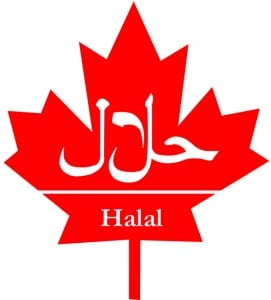Halal meat is in demand thanks to Canada’s rising Muslim population
By Rebecca Harris – Canadian Grocer
Salima Jivra is a first-generation Muslim Canadian who gets most of her shopping done at a mainstream grocer, but then also has to buy halal meat at a South-Asian food market.
“It would be more ideal to shop at a grocery store, where I can get everything: my normal groceries, some of the more ethnic-related items and then also my halal meat,” says Jivraj, founder of Toronto’s Halal Food Fest and operator of halal-focused website HalalFoodie.ca.
Grocers that carry halal meat (meaning meat that is slaughtered according to Islamic dietary law) could tap into a burgeoning market. According to Statistics Canada, the Muslim population exceeded the one million mark in 2011, almost doubling its population for the third consecutive decade.
“That is clearly a boost to halal products,” says Svetlana Uduslivaia, senior research analyst at Chicago-based Euromonitor International. “Right now, a lot of this need is being met by ethnic-food retailers as opposed to mainstream retailers.”
Even if mainstream grocers served up halal meat, they’d have to address several issues. There is a serious spiritual component to purchasing halal meat to consider, says Jivraj.
“[Muslims] have to trust that there’s no cross-contamination, [know that] it’s coming from a proper source and that the people who are cutting and packing it are knowledgeable enough to answer their questions.”
A 2009 study from Interpoc Inc. for the government of Manitoba estimated the total halal meat market in Canada at $214 million, of which $80 million is from the beef market. By now, the market is likely worth much more than that.
Pam Kellogg, senior director of marketing at Maple Leaf Foods, points to Nielsen sales volume stats that show the halal segment of fresh chicken is growing at 6% per year, which is greater than the total fresh chicken growth at 1%.
 In 2012 Maple Leaf Foods launched Mina, a line of hand-slaughtered chicken that is certified by the Halal Meat Authority.
In 2012 Maple Leaf Foods launched Mina, a line of hand-slaughtered chicken that is certified by the Halal Meat Authority.
The fresh line has six varieties including chicken breasts, thighs and drumsticks as well as several new frozen products that launched in October including chicken strips and a whole frozen turkey.
“Only a small portion of halal shoppers [buy] halal chicken at traditional grocery and mass stores because it’s difficult to find halal offerings that are zabeeha by hand,” says Kellogg, referring to the slaughtering process.
“Offering products such as Mina is an easy way to attract and retain an influential consumer population that’s seeking a trusted halal product in a convenient way,” Kellogg adds.
Consumer concerns about food safety caused by contamination scandals could drive further growth for both halal and kosher meats, which are both subject to rigorous standards and inspections. “They’re seen as safer bets,” says Uduslivaia.
According to Interpoc, which estimates Canada’s kosher beef market at $130 million, consumers of kosher beef in North America have grown from the traditional Jewish population to include “nondenominational consumers seeking higher standards of control, production and fair trade.” People with concerns about the well-being of animals also tend to fit into this group.
Taste is another reason people choose to buy kosher meat, even if they themselves aren’t strictly kosher, says Alexei Tsvetkov, CEO of Yummy Market.
“The animals are processed differently before appearing on the counter, and that changes the taste,” he says. “Many people like that.”



